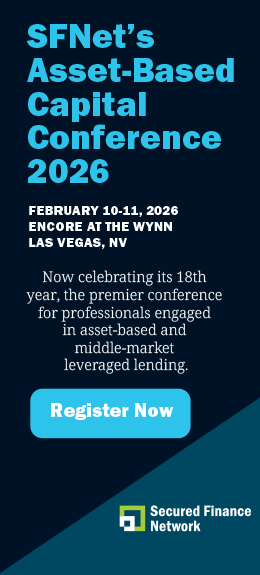- Oz Lindley Joins Pathward’s Commercial Finance Team
- Opening Doors: How SFNet’s Guest Lecture Program Connects Students to Careers in Secured Finance
- Building the Future of Asset-Based Lending at SLR Capital Partners: An Interview with Mac Fowle and Cedric Henley
- The Cost of Uncertainty
- The State of Lender Finance
The State of Asset-Based Lending in Q1 2024: A Comprehensive Analysis
August 6, 2024
By SFNet's Data Committee
The first quarter of 2024 presented a complex landscape for asset-based lending (ABL) and the broader economic context. According to the SFNet Q1 2024 Asset-Based Lending and Confidence Index surveys, the ABL industry exhibited both stability and cautious optimism despite the economic headwinds.
This report, based on SFNet’s detailed findings, provides a comprehensive overview of the economic conditions, lender confidence, commitments, outstandings, and portfolio performance within the ABL sector.
Economic Context
The U.S. economy had a slow start to 2024, with a muted growth rate of 1.3% in the first quarter. Softer-than-expected consumer spending and declining business inventories were significant contributors to this modest growth. Rising debt burdens and slowing real income growth have started to pinch consumer spending, which has been a driving force in the economy over recent years. The unemployment rate edged up to 4%, with a corresponding decline in job postings, signaling a softening labor market. However, the labor market remains robust enough to prevent a collapse in consumer spending.
Progress on disinflation is promising, with the May Consumer Price Index (CPI) report showing unchanged prices, alleviating fears of renewed inflation. The Federal Reserve is widely expected to maintain its cautious stance, likely refraining from rate cuts until the fall, aiming to achieve a “soft landing” – reducing inflation without triggering a recession.
Click here to continue reading.
This report, based on SFNet’s detailed findings, provides a comprehensive overview of the economic conditions, lender confidence, commitments, outstandings, and portfolio performance within the ABL sector.
Economic Context
The U.S. economy had a slow start to 2024, with a muted growth rate of 1.3% in the first quarter. Softer-than-expected consumer spending and declining business inventories were significant contributors to this modest growth. Rising debt burdens and slowing real income growth have started to pinch consumer spending, which has been a driving force in the economy over recent years. The unemployment rate edged up to 4%, with a corresponding decline in job postings, signaling a softening labor market. However, the labor market remains robust enough to prevent a collapse in consumer spending.
Progress on disinflation is promising, with the May Consumer Price Index (CPI) report showing unchanged prices, alleviating fears of renewed inflation. The Federal Reserve is widely expected to maintain its cautious stance, likely refraining from rate cuts until the fall, aiming to achieve a “soft landing” – reducing inflation without triggering a recession.
Click here to continue reading.

